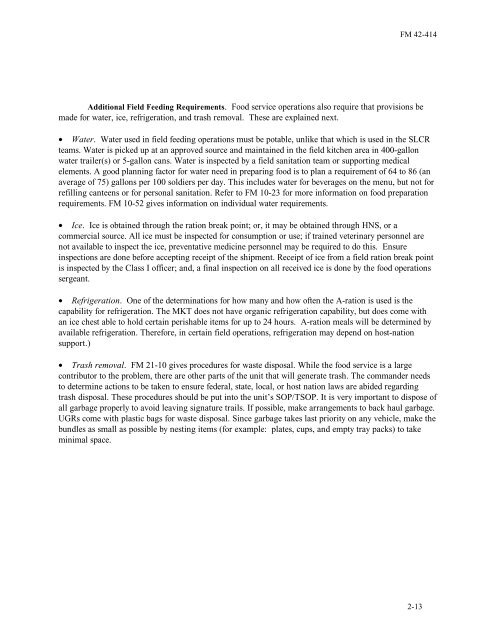Tactics, techniques, and procedures for - Army Electronic ...
Tactics, techniques, and procedures for - Army Electronic ...
Tactics, techniques, and procedures for - Army Electronic ...
Create successful ePaper yourself
Turn your PDF publications into a flip-book with our unique Google optimized e-Paper software.
FM 42-414<br />
Additional Field Feeding Requirements. Food service operations also require that provisions be<br />
made <strong>for</strong> water, ice, refrigeration, <strong>and</strong> trash removal. These are explained next.<br />
• Water. Water used in field feeding operations must be potable, unlike that which is used in the SLCR<br />
teams. Water is picked up at an approved source <strong>and</strong> maintained in the field kitchen area in 400-gallon<br />
water trailer(s) or 5-gallon cans. Water is inspected by a field sanitation team or supporting medical<br />
elements. A good planning factor <strong>for</strong> water need in preparing food is to plan a requirement of 64 to 86 (an<br />
average of 75) gallons per 100 soldiers per day. This includes water <strong>for</strong> beverages on the menu, but not <strong>for</strong><br />
refilling canteens or <strong>for</strong> personal sanitation. Refer to FM 10-23 <strong>for</strong> more in<strong>for</strong>mation on food preparation<br />
requirements. FM 10-52 gives in<strong>for</strong>mation on individual water requirements.<br />
• Ice. Ice is obtained through the ration break point; or, it may be obtained through HNS, or a<br />
commercial source. All ice must be inspected <strong>for</strong> consumption or use; if trained veterinary personnel are<br />
not available to inspect the ice, preventative medicine personnel may be required to do this. Ensure<br />
inspections are done be<strong>for</strong>e accepting receipt of the shipment. Receipt of ice from a field ration break point<br />
is inspected by the Class I officer; <strong>and</strong>, a final inspection on all received ice is done by the food operations<br />
sergeant.<br />
• Refrigeration. One of the determinations <strong>for</strong> how many <strong>and</strong> how often the A-ration is used is the<br />
capability <strong>for</strong> refrigeration. The MKT does not have organic refrigeration capability, but does come with<br />
an ice chest able to hold certain perishable items <strong>for</strong> up to 24 hours. A-ration meals will be determined by<br />
available refrigeration. There<strong>for</strong>e, in certain field operations, refrigeration may depend on host-nation<br />
support.)<br />
• Trash removal. FM 21-10 gives <strong>procedures</strong> <strong>for</strong> waste disposal. While the food service is a large<br />
contributor to the problem, there are other parts of the unit that will generate trash. The comm<strong>and</strong>er needs<br />
to determine actions to be taken to ensure federal, state, local, or host nation laws are abided regarding<br />
trash disposal. These <strong>procedures</strong> should be put into the unit’s SOP/TSOP. It is very important to dispose of<br />
all garbage properly to avoid leaving signature trails. If possible, make arrangements to back haul garbage.<br />
UGRs come with plastic bags <strong>for</strong> waste disposal. Since garbage takes last priority on any vehicle, make the<br />
bundles as small as possible by nesting items (<strong>for</strong> example: plates, cups, <strong>and</strong> empty tray packs) to take<br />
minimal space.<br />
2-13

















